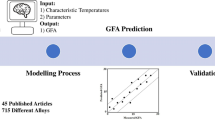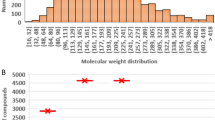Abstract
Low aqueous solubility is a common and serious challenge for most drug substances not only in development but also in the market, and it may cause low absorption and bioavailability as a result. Amorphization is an intermolecular modification strategy to address the issue by breaking the crystal lattice and enhancing the energy state. However, due to the physicochemical properties of the amorphous state, drugs are thermodynamically unstable and tend to recrystallize over time. Glass-forming ability (GFA) is an experimental method to evaluate the forming and stability of glass formed by crystallization tendency. Machine learning (ML) is an emerging technique widely applied in pharmaceutical sciences. In this study, we successfully developed multiple ML models (i.e., random forest (RF), XGBoost, and support vector machine (SVM)) to predict GFA from 171 drug molecules. Two different molecular representation methods (i.e., 2D descriptor and Extended-connectivity fingerprints (ECFP)) were implemented to process the drug molecules. Among all ML algorithms, 2D-RF performed best with the highest accuracy, AUC, and F1 of 0.857, 0.850, and 0.828, respectively, in the testing set. In addition, we conducted a feature importance analysis, and the results mostly agreed with the literature, which demonstrated the interpretability of the model. Most importantly, our study showed great potential for developing amorphous drugs by in silico screening of stable glass formers.
Graphical Abstract








Similar content being viewed by others
Data Availability
The authors confirm that the data supporting the findings of this study are available within the article.
Abbreviations
- GFA:
-
Glass-forming ability
- AI:
-
Artificial intelligence
- ML:
-
Machine learning
- RF:
-
Random forest
- SVM:
-
Support vector machine
- SHAP:
-
SHapley Additive exPlanations
- ECFP:
-
Extended-connectivity fingerprints
- IG:
-
Information gain
- ACC:
-
Accuracy
- F1:
-
F1 score
- ROC:
-
Receiving operating characteristics
- AUC:
-
Area under the curve
- GF:
-
Glass former
References
Savjani KT, Gajjar AK, Savjani JK. Drug solubility: importance and enhancement techniques. 1957;2012. https://doi.org/10.5402/2012/195727.
Jermain S v., Brough C, Williams RO. Amorphous solid dispersions and nanocrystal technologies for poorly water-soluble drug delivery – an update. Int J Pharm. 2018;535(1–2):379–392. https://doi.org/10.1016/J.IJPHARM.2017.10.051.
Adachi M, Hinatsu Y, Kusamori K, et al. Improved dissolution and absorption of ketoconazole in the presence of organic acids as pH-modifiers. Eur J Pharm Sci. 2015;76:225–30. https://doi.org/10.1016/J.EJPS.2015.05.015.
Balakrishnan A, Rege BD, Amidon GL, Polli JE. Surfactant-mediated dissolution: contributions of solubility enhancement and relatively low micelle diffusivity. J Pharm Sci. 2004;93(8):2064–75. https://doi.org/10.1002/JPS.20118.
Jain NK, Gupta U. Application of dendrimer–drug complexation in the enhancement of drug solubility and bioavailability. 2008;4(8):1035–1052. 101517/17425255481035.
Kolašinac N, Kachrimanis K, Homšek I, Grujić B, Urić Z, Ibrić S. Solubility enhancement of desloratadine by solid dispersion in poloxamers. Int J Pharm. 2012;436(1–2):161–70. https://doi.org/10.1016/J.IJPHARM.2012.06.060.
Almeida Sousa L, Reutzel-Edens SM, Stephenson GA, Taylor LS. Supersaturation potential of salt, co-crystal, and amorphous forms of a model weak base. Published online. 2016. https://doi.org/10.1021/acs.cgd.5b01341.
Bogner RH, Murdande SB, Pikal MJ, Shanker RM. Solubility advantage of amorphous pharmaceuticals: II. application of quantitative thermodynamic relationships for prediction of solubility enhancement in structurally diverse insoluble pharmaceuticals. Pharm Res. 2010;27(12):2704-2714. https://doi.org/10.1007/S11095-010-0269-5/TABLES/4.
Rasenack N, Müller BW. Dissolution rate enhancement by in situ micronization of poorly water-soluble drugs. Pharmaceutical Research. 2002;19(12):1894–900. https://doi.org/10.1023/A:1021410028371.
Patel VR, Agrawal YK. Nanosuspension: an approach to enhance solubility of drugs. J Adv Pharm Technol Res. 2011;2(2):81. https://doi.org/10.4103/2231-4040.82950.
Rams-Baron M, Jachowicz R, Boldyreva E, Zhou D, Jamroz W, Paluch M. Why amorphous drugs? Amorphous Drugs. Published online 2018:1–7. https://doi.org/10.1007/978-3-319-72002-9_1.
Zografi G, Sciences ANJ of P, undefined. Interrelationships between structure and the properties of amorphous solids of pharmaceutical interest. Elsevier. 2017 Accessed November 13, 2022. https://www.sciencedirect.com/science/article/pii/S0022354916414115.
Baird JA, van Eerdenbrugh B, Taylor LS. A Classification system to assess the crystallization tendency of organic molecules from undercooled melts. J Pharm Sci. 2010;99(9):3787–806. https://doi.org/10.1002/JPS.22197.
Wyttenbach N, Kirchmeyer W, Alsenz J, Kuentz M. Theoretical considerations of the Prigogine-Defay ratio with regard to the glass-forming ability of drugs from undercooled melts. Mol Pharm. 2016;13(1):241–50. https://doi.org/10.1021/ACS.MOLPHARMACEUT.5B00688/SUPPL_FILE/MP5B00688_SI_001.PDF.
Jiang J, Ma X, Ouyang D, Williams Iii RO. Emerging artificial intelligence (AI) technologies used in the development of solid dosage forms. Pharmaceutics. 2022;14(11):2257. https://doi.org/10.3390/PHARMACEUTICS14112257.
Wang W, Ye Z, Gao H, Ouyang D. Computational pharmaceutics - a new paradigm of drug delivery. J Control Release. 2021;338:119–36. https://doi.org/10.1016/J.JCONREL.2021.08.030.
Jiang J, Peng HH, Yang Z, et al 2022 The applicationsof machine learning (ML) in designing dry powder for inhalation by using thin-film-freezing technology. Int J Pharm. 2022 626:122179. https://doi.org/10.1016/J.IJPHARM.2022.122179.
Ma X, Kittikunakorn N, Sorman B, et al. Application of deep learning convolutional neural networks for internal tablet defect detection: high accuracy, throughput, and adaptability. J Pharm Sci. 2020;109(4):1547–57. https://doi.org/10.1016/J.XPHS.2020.01.014.
Westphal E, Seitz HA. machine learning method for defect detection and visualization in selective laser sintering based on convolutional neural networks. Addit Manuf. 2021;41:101965. https://doi.org/10.1016/J.ADDMA.2021.101965.
Ficzere M, Alexandra Mészáros L, Kállai-Szabó N, et al. Real-time coating thickness measurement and defect recognition of film coated tablets with machine vision and deep learning. Int J Pharm. 2022;623:121957. https://doi.org/10.1016/J.IJPHARM.2022.121957.
Jiang Junhuang, Lu Anqi, Ma Xiangyu, Ouyang Defang, Williams O. Robert III. The applications of machine learning to predict the forming of chemically stable amorphous solid dispersions prepared by hot-melt extrusion. International Journal of Pharmaceutics: X. 2023;5:100164. https://doi.org/10.1016/j.ijpx.2023.100164.
Dong J, Gao H, PharmSD Ouyang D. A novel AI-based computational platform for solid dispersion formulation design. Int J Pharm. 2021;604:120705. https://doi.org/10.1016/J.IJPHARM.2021.120705.
Han R, Xiong H, Ye Z, et al. Predicting physical stability of solid dispersions by machine learning techniques. J Control Release. 2019;311–312:16–25. https://doi.org/10.1016/J.JCONREL.2019.08.030.
Han R, Yang Y, Li X, Ouyang D. Predicting oral disintegrating tablet formulations by neural network techniques. Asian J Pharm Sci. 2018;13(4):336–42. https://doi.org/10.1016/J.AJPS.2018.01.003.
Breiman L. Random forests. Mach Learn. 2001;45(1):5–32. https://doi.org/10.1023/A:1010933404324.
Adankon MM, Cheriet M. Support Vector Machine. Encyclopedia of Biometrics. Published online 2009:1303–1308. https://doi.org/10.1007/978-0-387-73003-5_299.
Chen T, CGacm sigkdd international conference on knowledge, 2016 undefined. Xgboost: A scalable tree boosting system. dl.acm.org. 2016;13–17-August-2016:785–794. https://doi.org/10.1145/2939672.2939785.
Ke G, Meng Q, Finley T, et al Lightgbm: a highly efficient gradient boosting decision tree. papers.nips.cc. Accessed January 27, 2022. http://papers.nips.cc/paper/6907-a-highly-efficient-gradient-boosting-decision-tree.
Toropov AA, Toropova AP, Martyanov SE, et al. Comparison of SMILES and molecular graphs as the representation of the molecular structure for QSAR analysis for mutagenic potential of polyaromatic amines. Chemom Intell Lab Syst. 2011;109(1):94–100. https://doi.org/10.1016/J.CHEMOLAB.2011.07.008.
Alhalaweh A, Alzghoul A, Kaialy W, Mahlin D, Bergström CAS. Computational predictions of glass-forming ability and crystallization tendency of drug molecules. Mol Pharm. 2014;11(9):3123–32. https://doi.org/10.1021/MP500303A/ASSET/IMAGES/LARGE/MP-2014-00303A_0008.JPEG.
Edueng K, Bergström CAS, Gråsjö J, Mahlin D. Long-term physical (in)stability of spray-dried amorphous drugs: relationship with glass-forming ability and physicochemical properties. Pharmaceutics. 2019;11(9):425. https://doi.org/10.3390/PHARMACEUTICS11090425.
Atawa B, Couvrat N, Coquerel G, Dargent E, Saiter A. Impact of chirality on the glass forming ability and the crystallization from the amorphous state of 5-ethyl-5-methylhydantoin, a chiral poor glass former. Int J Pharm. 2018;540(1–2):11–21. https://doi.org/10.1016/J.IJPHARM.2018.01.050.
Wyttenbach N, Kuentz M. Glass-forming ability of compounds in marketed amorphous drug products. Eur J Pharm Biopharm. 2017;112:204–8. https://doi.org/10.1016/J.EJPB.2016.11.031.
Kapourani A, Vardaka E, Katopodis K, Kachrimanis K, Barmpalexis P. Crystallization tendency of APIs possessing different thermal and glass related properties in amorphous solid dispersions. Int J Pharm. 2020;579:119149. https://doi.org/10.1016/J.IJPHARM.2020.119149.
Blaabjerg LI, Lindenberg E, Löbmann K, Grohganz H, Rades T. Is there a correlation between the glass forming ability of a drug and its supersaturation propensity? Int J Pharm. 2018;538(1–2):243–9. https://doi.org/10.1016/J.IJPHARM.2018.01.013.
Lapuk SE, Mukhametzyanov TA, Schick C, Gerasimov A v. Crystallization kinetics and glass-forming ability of rapidly crystallizing drugs studied by Fast Scanning Calorimetry. Int J Pharm. 2021;599:120427. https://doi.org/10.1016/J.IJPHARM.2021.120427.
Safna Hussan KP, Thayyil MS, Deshpande SK, Jinitha T, v., Manoj K, Ngai KL. Molecular dynamics, physical and thermal stability of neat amorphous amlodipine besylate and in binary mixture. Eur J Pharm Sci. 2018;119:268–78. https://doi.org/10.1016/J.EJPS.2018.04.030.
Baghel S, Cathcart H, Redington W, O’Reilly NJ. An investigation into the crystallization tendency/kinetics of amorphous active pharmaceutical ingredients: a case study with dipyridamole and cinnarizine. Eur J Pharm Biopharm. 2016;104:59–71. https://doi.org/10.1016/J.EJPB.2016.04.017.
Sahakijpijarn S, Moon C, Koleng JJ, Christensen DJ, Williams RO. Development of remdesivir as a dry powder for inhalation by thin film freezing. Pharmaceutics. 2020; 12(11):1002. https://doi.org/10.3390/PHARMACEUTICS12111002.
Blaabjerg LI, Bulduk B, Lindenberg E, Löbmann K, Rades T, Grohganz H. Influence of glass forming ability on the physical stability of supersaturated amorphous solid dispersions. J Pharm Sci. 2019;108(8):2561–9. https://doi.org/10.1016/J.XPHS.2019.02.028.
Baird JA, Santiago-Quinonez D, Rinaldi C, Taylor LS. Role of viscosity in influencing the glass-forming ability of organic molecules from the undercooled melt state. Pharm Res. 2012;29(1):271–84. https://doi.org/10.1007/S11095-011-0540-4/FIGURES/5.
Yang L, Shami A. On hyperparameter optimization of machine learning algorithms: theory and practice. Neurocomputing. 2020;415:295–316. https://doi.org/10.1016/J.NEUCOM.2020.07.061.
Ye Z, Ouyang D. Prediction of small-molecule compound solubility in organic solvents by machine learning algorithms. Ye and Ouyang Journal of Cheminformatics. 2021;13:98. https://doi.org/10.1186/s13321-021-00575-3.
Kopitar L, Cilar L, Kocbek P, Stiglic G. Local vs. global interpretability of machine learning models in type 2 diabetes mellitus screening. Lecture Notes in Computer Science (including subseries Lecture Notes in Artificial Intelligence and Lecture Notes in Bioinformatics). 2019;11979 LNAI:108–119. https://doi.org/10.1007/978-3-030-37446-4_9/FIGURES/3.
Jadhav Swati, He Hongmei, Jenkins Karl. Information gain directed genetic algorithm wrapper feature selection for credit rating. Appl Soft Comput. 2018;69:541–53. https://doi.org/10.1016/j.asoc.2018.04.033.
Nurzyńska K, Booth J, Roberts CJ, McCabe J, Dryden I, Fischer PM. Long-term amorphous drug stability predictions using easily calculated, predicted, and measured parameters. Mol Pharm. 2015;12(9):3389–98. https://doi.org/10.1021/ACS.MOLPHARMACEUT.5B00409/ASSET/IMAGES/LARGE/MP-2015-00409X_0008.JPEG.
Hall LH, Kier LB. The molecular connectivity chi indexes and kappa shape indexes in structure-property modeling. Published online January 5, 2007:367–422. https://doi.org/10.1002/9780470125793.CH9.
Wildman SA, Crippen GM. Prediction of physicochemical parameters by atomic contributions. J Chem Inf Comput Sci. 1999;39(5):868–73. https://doi.org/10.1021/CI990307L/ASSET/IMAGES/LARGE/CI990307LF00002.JPEG.
Gasteiger J, Marsili M. Iterative partial equalization of orbital electronegativity—a rapid access to atomic charges. Tetrahedron. 1980;36(22):3219–28. https://doi.org/10.1016/0040-4020(80)80168-2.
Mahlin D, Bergström CAS. Early drug development predictions of glass-forming ability and physical stability of drugs. Eur J Pharm Sci. 2013;49(2):323–32. https://doi.org/10.1016/J.EJPS.2013.03.016.
Kawakami K. Crystallization tendency of pharmaceutical glasses: relevance to compound properties, impact of formulation process, and implications for design of amorphous solid dispersions. Pharmaceutics 2019, 2019;11(5):202. https://doi.org/10.3390/PHARMACEUTICS11050202.
Author information
Authors and Affiliations
Contributions
Junhuang Jiang: conceptualization, methodology, data curation, software, visualization, writing—original draft. Defang Ouyang: conceptualization, validation, writing—review and editing. Robert O. Williams III: conceptualization, writing—review and editing, supervision.
Corresponding author
Ethics declarations
Conflicts of interest
The authors declare no competing interests.
Additional information
Publisher's note
Springer Nature remains neutral with regard to jurisdictional claims in published maps and institutional affiliations.
Supplementary information
Below is the link to the electronic supplementary material.
Rights and permissions
Springer Nature or its licensor (e.g. a society or other partner) holds exclusive rights to this article under a publishing agreement with the author(s) or other rightsholder(s); author self-archiving of the accepted manuscript version of this article is solely governed by the terms of such publishing agreement and applicable law.
About this article
Cite this article
Jiang, J., Ouyang, D. & Williams, R.O. Predicting Glass-Forming Ability of Pharmaceutical Compounds by Using Machine Learning Technologies. AAPS PharmSciTech 24, 103 (2023). https://doi.org/10.1208/s12249-023-02535-6
Received:
Accepted:
Published:
DOI: https://doi.org/10.1208/s12249-023-02535-6




